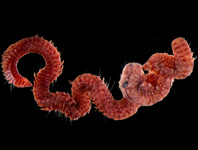Abstract
The male of the endangered ant Dinoponera lucida Emery is described, providing morphometric measurements, high-resolution images, and a distribution map of the species. This ant inhabits the Brazilian Atlantic forest, an ecosystem strongly impacted by fragmentation. The males show clear morphological differences from the known males of other species of Dinoponera. We briefly discuss the relevance of the male description for the conservation strategies of this ant.
References
Azevedo, C.O., Dal Molin, A., Penteado-Dias, A., Macedo, A.C.C., Rodriguez-V., B., Dias, B.Z.K., Waichert, C., Aquino, D., Smith, D.R., Shimbori, E.M., Noll, F.B., Gibson, G., Onody, H.C., Carpenter, J.M., Lattke, J.E., Ramos, K., Williams, K., Masner, L., Kimsey, L.S., Tavares, M.T., Olmi, M., Buffington, M.L., Ohl, M., Sharkey, M., Johnson, N.F., Kawada, R., Gonçalves, R.B., Feitosa, R.M., Heydon, S., Guerra, T.M., da Silva, T.S.R. & Costa, V. (2015) Checklist of the genera of Hymenoptera (Insecta) from Espírito Santo, Brazil. Boletim do Museu de Biologia Mello Leitão, 37, 313–343.
Boudinot, B.E., Sumnicht, T.P. & Adams, R.M. (2013) Central American ants of the genus Megalomyrmex Forel (Hymenoptera: Formicidae): six new species and keys to workers and males. Zootaxa, 3732 (1), 1–82.
https://doi.org/10.11646/zootaxa.3732.1.1Boudinot, B.E. (2015) Contributions to the knowledge of Formicidae (Hymenoptera, Aculeata): a new diagnosis of the family, the first global male-based key to subfamilies, and a treatment of early branching lineages. European Journal of Taxonomy, 120, 1–62.
https://doi.org/10.5852/ejt.2015.120Campiolo, S. & Delabie, J.H.C. (2008) Dinoponera lucida Emery 1901. In: Machado, A.B.M., Drummond, G.M. & Paglia, A.P. (Eds.), Livro vermelho da fauna brasileira ameaçada de extinção. Vol. I. Ministério do Meio Ambiente, Biodiversidade, 19, pp. 388–389.
Carwardine. J., Wilson, K.A., Watts, M., Etter, A., Klein, C.J. & Possingham, H.P. (2008) Avoiding costly conservation mistakes: the importance of defining actions and costs in spatial priority setting. PLoS ONE, 3 (7), e2586.
https://doi.org/10.1371/journal.pone.0002586Di Marco, M., Watson, J.E.M., Possingham, H.P. & Venter, O. (2017) Limitations and trade-offs in the use of species distribution maps for protected area planning. Journal of Applied Ecology, 54, 402–411.
https://doi.org/10.1111/1365-2664.12771Dubois, A. (2003) The relationships between taxonomy and conservation biology in the century of extinctions. Comptes Rendus Biologies, 326, 9–21.
https://doi.org/10.1016/S1631-0691(03)00022-2Emery, C. (1901) Notes sur les sous-familles des Dorylines et Ponérines (Famille des Formicides). Annales de la Société Entomologique de Belgique, 45, 32–54.
Kempf, W.W. (1971) A preliminary review of the ponerine ant genus Dinoponera Roger (Hymenoptera: Formicidae). Studia Entomologica, 14, 369–394.
Lenhart, P., Dash, S.T. & Mackay, W.P. (2013) A revision of the giant Amazonian ants of the genus Dinoponera (Hymenoptera, Formicidae). Journal of Hymenoptera Research, 31, 119–164.
https://doi.org/10.3897/jhr.31.4335Peixoto, A.V., Campiolo, S., Lemes, T.N., Delabie, J.H. & Hora, R.R. (2008) Comportamento e estrutura reprodutiva da formiga Dinoponera lucida Emery (Hymenoptera, Formicidae). Revista Brasileira de Entomologia, 52 (1), 88–94.
https://doi.org/10.1590/S0085-56262008000100016Peixoto, A.V., Campiolo, S. & Delabie, J.H.C. (2010) Basic ecological information about the threatened ant, Dinoponera lucida Emery (Hymenoptera: Formicidae: Ponerinae), aiming its effective long-term conservation. In: Tepper, G.H. (Ed.), Species Diversity and Extinction. Nova Science Publishers, Inc., New York, NY, pp. 183–213.
QGIS Development Team (2017) QGIS 2.14 Geographic Information System User Guide. Open Source Geospatial Foundation Project. Available from: https://docs.qgis.org/2.14/en/docs/user_manual/ (accessed 1 June 2017)
Ribeiro, M.C., Metzger, J.P., Martensen, A.C., Ponzoni, F.J. & Hirota, M.M. (2009) The Brazilian Atlantic Forest: How much is left, and how is the remaining forest distributed? Implications for conservation. Biological Conservation, 142 (6), 1141–1153.
https://doi.org/10.1016/j.biocon.2009.02.021Saatchi, S., Agosti, D., Alger, K., Delabie, J. & Musinsky, J. (2001) Examining fragmentation and loss of primary forest in the southern Bahian Atlantic forest of Brazil with radar imagery. Conservation Biology, 15 (4), 867–875.
https://doi.org/ 10.1046/j.1523-1739.2001.015004867.xSchmidt, C. (2013) Molecular phylogenetics of ponerine ants (Hymenoptera: Formicidae: Ponerinae). Zootaxa, 3647 (2), 201–250.
https://doi.org/10.11646/zootaxa.3647.2.1Schmidt, C.A. & Shattuck S.O. (2014) The higher classification of the ant subfamily Ponerinae (Hymenoptera: Formicidae), with a review of ponerine ecology and behavior. Zootaxa, 3817 (1), 1–242.
https://doi.org/10.11646/zootaxa.3817.1.1Yoshimura, M. & Fisher, B.L. (2011) A revision of male ants of the Malagasy region (Hymenoptera: Formicidae): Key to genera of the subfamily Dolichoderinae. Zootaxa, 2794, 1–34.

